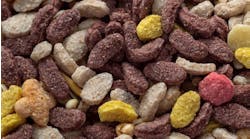People love their pets and are willing to spend serious money keeping them healthy. It’s no surprise then that key trends in pet food processing mirror trends in human food: clean label, alternative proteins and more healthful ingredients and processes.
“Pet food makers have absolutely seen an increased shopper expectation for pet food products on the shelf that mirrors human food options,” says Mary Emma Young, senior director of communications for the Pet Food Institute.
“Our society’s relationship to pets has evolved over the decades, with dogs and cats now being beloved members of the family," she continues. "Whether it’s clean label, sustainability claims, functional nutrition or free-from claims, pet lovers increasingly look for labels and packaging that reflect their personal food philosophy and needs.”
A little fruity
Fruit ingredients are a relatively new category of pet food ingredients that embodies the concept of health. Processors have learned that the nutrients and fiber in fruit can be successfully incorporated into pet food to increase the overall nutritional value and, in some cases, the flavor and color.
For example, puree from strawberries, raspberries and blueberries is a high-fiber ingredient that makes its way into some pet foods today. Dogs and cats both benefit from that fiber, even though those animals are generally considered carnivores.
"When we first attended the annual Global Pet Expo a few years ago, there was very little fruit found in pet products," recalls a spokesperson for the U.S. Highbush Blueberry Council. "In those days the thought of fruits and vegetables in dog and cat food seemed unusual [but] an intriguing concept to many we talked to.
"What they were most intrigued by was the health research and consumer studies that showed consumers identifying blueberries with antioxidants and wellbeing. The idea of including fruit in pet food sparked interest and those we visited were enthusiastic about discussing the potential with their R&D folks."
Other fruits also play key roles in pet food formulations. According to the Mintel Global New Products Database, the use of citrus fiber in pet foods jumped 437% in the year ending March 2019. Apple and cranberry usage also has jumped in recent years.
Pet food is a growing market for ingredients from Tree Top, a growers collective that converts excess and unattractive fruit into food ingredients.
“Dried apples and fruit powder contain fiber, which can help bind water, [which makes them] a beneficial addition to wet pet food products,” notes Jeannie Swedberg, director of business development for Tree Top, a growers collective in the state of Washington that converts excess and unattractive fruit into food ingredient products.
“Fruit ingredients can also aid with product texture, add color and help control moisture. Fruit ingredients give formulators the opportunity to tap into inherent nutraceutical or phytonutrient qualities, such as fruits high in antioxidants like blueberries or cranberries. These antioxidant components, which combat free radicals, can aid a number of pet health concerns.”
An example of fruit in dog food is Homestyle Creations Bananas, Cranberries and Blueberries Mixer from FreshPet. This product uses a combination of those fruits mixed with broth. It is designed as an additive to other Homestyle Creations dog food products, not as a stand-alone pet food.
Primal Pet Foods, which specializes in pet food made with organic ingredients, also includes fruit in its formulations.
“Blueberries and cranberries offer a wide array of phytonutrients and are known for their anti-inflammatory properties,” the company explains in a blog entry. “Both are rich in manganese essential for growth, metabolism, and the body’s antioxidant system. Additionally, blueberries and cranberries promote urinary tract health.”
Veggie tales
Fruits aren’t the only plant-based product found in pet food – vegetables also offer important nutritional benefits. For example, dark leafy green vegetables contain calcium, potassium and magnesium; and broccoli and kale are rich in phytonutrients.
Primal includes organic leafy greens, broccoli, carrots, celery and other vegetables in some of their products.
“Produce provides nutrients that your pet cannot get from human-grade muscle meat, organ meat and bone alone,” the company says. “We choose to include these nutrients from whole food ingredients like organic fruits, organic vegetables and unrefined supplements, rather than using synthetic vitamin and mineral packs. Our canine diets average 85% meat plus 15% produce/supplements and our feline diets average 93% meat plus 7% produce/supplements.”
Nutro, a Mars Petcare brand, blends salmon, lentil, blueberry “and a hint of basil” for a grain-free dog food. It’s also “made with non-GMO ingredients.”
By-products = sustainability
Another trend in pet food processing that mirrors a trend in human food processing is the desire for sustainability. When it comes to pet food, sustainability is well expressed by the use of meat by-products.
“The pet food industry is such an important partner in the sustainability story,” Young says. “While ‘by-products’ has been seen as a dirty word, by using these ingredients pet food makers are utilizing parts of the farm animal that Americans choose not to eat, but are still full of nutrition
"No livestock is raised in the United States for the sole purpose of being used in pet food. Instead the industry is engaging the existing food system to help reduce food waste and minimize the environmental footprint of food production.”
For example, rendered poultry fat is commonly used in pet foods to add calories and impart a chicken flavor. Typically, the muscle pieces of a chicken – breast, drumstick, etc. – are used for human consumption, leaving behind internal organs, feathers and many other animal parts. Those parts, commonly called “offal,” don’t go to waste – much of it ends up in pet food.
“Poultry fat is a high-value product of rendering, and all of it’s used,” says Paul Bredwell III, executive vice president-regulatory programs for the U.S. Poultry & Egg Association. “It’s being rendered from the parts of the bird that humans don’t consume. That includes the insides of the bird, such as the digestive tract and those kinds of things. There’s not one part of the bird that’s not either consumed by humans or animals. Even the feathers, which are creatin, are pressure cooked – hydrolyzed – and that is fed back to animals as well.”
The sustainability story among pet food manufacturers extends to careful sourcing of ingredients, notes Carolyn Kennedy, principle of CK Pet Nutrition, a consultancy.
“Pet food manufacturers have always tried to source locally,” Kennedy says. “It saves on shipping costs, creates longer-lasting relationships and is now an important part of reducing the carbon footprint.”
Alternative proteins
Dogs and cats are mostly carnivores, so meat is a vital part of their diet. But it doesn’t always need to come from an animal.
“Employing the same fermentation technology that is used to produce ingredients for cheese-making or insulin for diabetics, [Bond Pet Foods] adjusts the process to instead harvest high-quality meat proteins like chicken, turkey, beef, pork and fish, but without the animal,” the company wrote in a press release.
The company expects to deliver its first products to store shelves sometime this year.
“With their proprietary approach, animal muscle protein genes are taken from a farm animal and added to a microbe such as yeast, then put into a fermentation tank and fed simple sugars, vitamins and minerals. This produces proteins that are nutritionally identical to their meat counterparts without the environmental, animal welfare and safety downsides. The ingredients are then used as the foundation of Bond's complete recipes.”
Another alternative protein that pet food processors have been experimenting with is insect protein. Insects have long been part of the diet for humans in certain parts of the world – such as crickets and ant larvae in Mexico – so it stands to reason that insect protein would also suit animals.
“Pet food makers are certainly exploring animal protein alternatives, such as insect-based recipes,” Young says. “However, it will be critical that these recipes still contain the essential nutrition, including certain amino acids and essential fatty acids, that dogs and cats require.”
Yora, a pet food business located in the United Kingdom, makes dog food from the larvae of Hermetia illucens larvae, also known as the “black soldier fly.” The company’s dog food also contains vegetables, including beets and potatoes.
“We take whole larvae and gently dry them to create a protein rich 'flour' that contains all of their precious nutrients and minerals,” the company states on its web site. “Our insect protein is even easier to digest than chicken, and much higher quality and less processed than the meat meal in most other pet foods.”
In the U.S., Hermetia illucens larvae so far have been approved by the Association of American Feed Control Officials only for fish food, not companion pets.
“Unfortunately, many of the ‘hot’ alternative animal proteins are not yet approved,” Kennedy explains. “Cricket meal and black soldier fly larvae have certainly been looked into by many, but as of yet these ingredients are not approved for use in pet food.”
Eggs may not be considered an “alternative” protein, but eggs in pet food can enhance the health characteristics. Eggs contain eight essential vitamins and minerals; antioxidants such as lutein and zeaxanthin; and protein with all nine essential amino acids. Sometimes eggshells are included in pet food as a source of calcium.
From a manufacturing perspective, eggs can be used a binder to hold together high-moisture ingredients, such as those found in canned pet food.
“There’s the obvious label appeal of putting ‘egg’ or ‘eggs’ on a label – an all-natural, simple, whole food ingredient that doesn’t take much space on an ingredient label,” says Elisa Maloberti, director of egg product marketing for the American Egg Board. “Eggs are a familiar, well understood ingredient. Pet parents eat eggs themselves and/or cook with them, so that gives them a certain comfort feeding them to their pets.”
Safety concerns
Pet food manufacturing is regulated much the same way human food is. The Food Safety Modernization Act of 2011, which overhauled food safety regulations, also includes provisions for pet food.
“Many people do not realize that pet food is among the most highly regulated food products in the U.S.,” Young notes. “In addition to state-level product registration, pet foods and treats are regulated under the federal level, including through the FSMA. As part of this, manufacturers must identify, evaluate and document potential risks during the production of pet food, from incoming ingredients and throughout manufacturing.”
That effort is daunting, but ultimately it addresses the fact that companion animals have an emotional hold on many Americans.
Says Kennedy: “Pets are now part of our families and consumers are looking for all the details regarding the food they are purchasing for their family pets, including details like where the ingredients come from, how they are raised and reared and even a company’s commitments to sustainability.”


